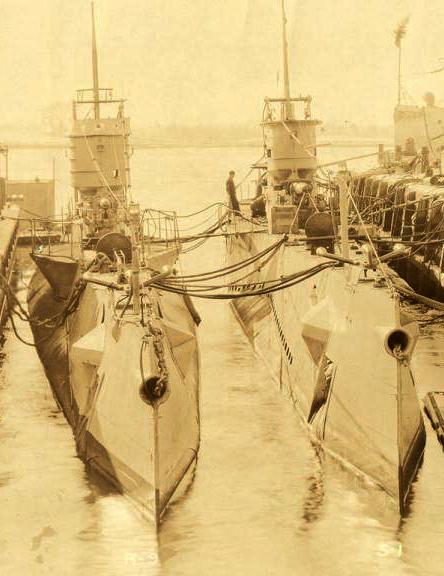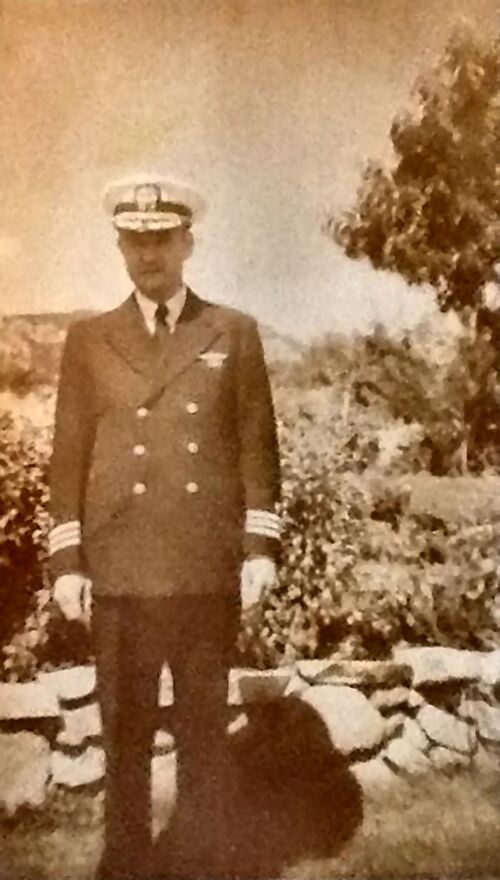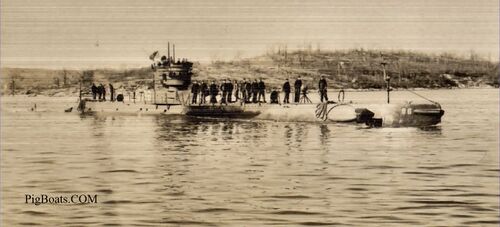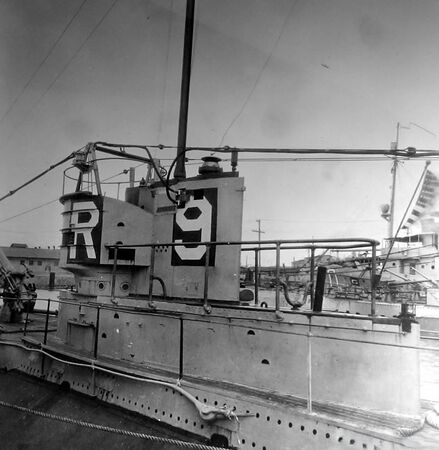R-9: Difference between revisions
No edit summary |
Pbcjohnston (talk | contribs) Added fairwater photos |
||
| (2 intermediate revisions by the same user not shown) | |||
| Line 1: | Line 1: | ||
[[File:R- | [[File:New Header 1 R-class.jpg]] | ||
<center> | |||
<gallery mode="nolines" perrow=2 widths="550px" heights="450px"> | |||
File:R-9 conning tower fairwater and bridge.jpg | |||
File:R-9 conning tower fairwater.jpg | |||
</gallery> | |||
</center> | |||
<div style="text-align: justify;"><span style="color:#00008B">Two closeups of R-9's conning tower fairwater while she was alongside at Naval Submarine Base, Pearl Harbor, late 1920s. | |||
The ribbing on the side of the bridge fairwater was intended to cut down on wave splash on the bridge, as the ridges broke up any blue water that impacted the bridge fairwater as the boat plunged into a wave. The port side running light is clearly visible at the forward edge of the "R". Just below the R are three round deadlight windows that let light into the conning tower itself. | |||
On top of the bridge an oval shaped pipe frame is in place. This frame held a canvas sun awning used to shield the bridge watchstanders. It was taken down prior to diving. On each side of the bridge are A-frame stanchions that support the heavy combination mine clearance and radio aerial wires. These long line wires run from bow to stern and up and over the bridge. This gives the radio aerials the necessary length to receive and transmit messages with the relatively low-powered radio sets of the day. The wires enter the interior through watertight junction boxes above the "9". The radio mast in the center of the fairwater is fully raised. This mast supports additional thin radio antenna wires. | |||
Immediately aft of the bridge there are seven round holes drilled into the side of the fairwater. These holes, with corresponding ones on the starboard side and ones on top of the fairwater, let air into the main induction piping that sends air aft to the engine room. At the aft end of the top of the fairwater is a mushroom-shaped ventilator intake, along with the boat's air whistle. | |||
In the second photo, just forward of the fairwater the boat's 3"/50 caliber Mk 7 Mod 19 gun can be seen, elevated skyward. This gives a good view of the removable box-shaped cover over the breech block at the back end of the weapon. | |||
Other R-class submarines are moored in the background, along with a [https://www.navsource.org/archives/09/32/32idx.htm '''Lapwing-class'''] submarine rescue vessel. | |||
<small> NARA photos courtesy of historylink101.com</small> | |||
[[File:Red bar sub new.jpg]] | |||
[[File:R-9 with s-1.jpg|left|500px]] | [[File:R-9 with s-1.jpg|left|500px]] | ||
| Line 13: | Line 35: | ||
[[File:R-9 | [[File:R-9 New London 1945.jpg|left|500px]] | ||
<div style="text-align: justify;"><span style="color:#00008B">This photo shows R-9 underway in | <div style="text-align: justify;"><span style="color:#00008B">This photo shows R-9 underway in the Thames River, about to moor at Submarine Base New London, Groton, CT. in 1945. R-9 was one of the R-boats that had been laid up in reserve in Philadelphia during the bulk of the 1930's. As the war crisis developed, the R-class boats were pulled out of mothballs and reactivated just in time to provide excellent training and patrol services in U.S. waters during the war. | ||
<small>Photo in the private collection of Ric Hedman</small> | <small>Photo in the private collection of Ric Hedman</small> | ||
Latest revision as of 15:44, 2 May 2025
The ribbing on the side of the bridge fairwater was intended to cut down on wave splash on the bridge, as the ridges broke up any blue water that impacted the bridge fairwater as the boat plunged into a wave. The port side running light is clearly visible at the forward edge of the "R". Just below the R are three round deadlight windows that let light into the conning tower itself.
On top of the bridge an oval shaped pipe frame is in place. This frame held a canvas sun awning used to shield the bridge watchstanders. It was taken down prior to diving. On each side of the bridge are A-frame stanchions that support the heavy combination mine clearance and radio aerial wires. These long line wires run from bow to stern and up and over the bridge. This gives the radio aerials the necessary length to receive and transmit messages with the relatively low-powered radio sets of the day. The wires enter the interior through watertight junction boxes above the "9". The radio mast in the center of the fairwater is fully raised. This mast supports additional thin radio antenna wires.
Immediately aft of the bridge there are seven round holes drilled into the side of the fairwater. These holes, with corresponding ones on the starboard side and ones on top of the fairwater, let air into the main induction piping that sends air aft to the engine room. At the aft end of the top of the fairwater is a mushroom-shaped ventilator intake, along with the boat's air whistle.
In the second photo, just forward of the fairwater the boat's 3"/50 caliber Mk 7 Mod 19 gun can be seen, elevated skyward. This gives a good view of the removable box-shaped cover over the breech block at the back end of the weapon.
Other R-class submarines are moored in the background, along with a Lapwing-class submarine rescue vessel.
NARA photos courtesy of historylink101.com

National Archives photo.

Vincent Moore was the Commanding Officer of the submarine USS R-9 from August 17, 1922 to May 23, 1923 when he was relieved of command due to severe health issues and given a medical discharge. He was recalled in 1942 to serve as an instructor in languages to the Navy.

Photo in the private collection of Ric Hedman
Page created by:
Ric Hedman & David Johnston
1999 - 2023 - PigBoats.COM©
Mountlake Terrace, WA, Norfolk, VA
webmaster at pigboats dot com


